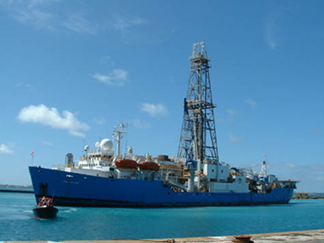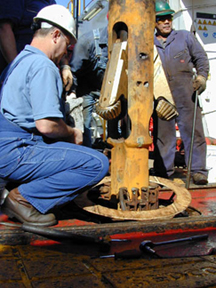Geotimes

Web
Extra Friday,
September 26, 2003
An ending begets a beginning
in oceanic drilling
On Sept. 6, 2003, the JOIDES Resolution sailed into port in St. John's,
Newfoundland, completing its 110th and final scientific expedition for the Ocean
Drilling Program (ODP). Scientists aboard the ship have drilled 650 sites around
the world in all of the oceans except the ice-covered Arctic to learn more about
the geologic processes that modify Earth, the history of those changes in oceans
and climate and the extent and depth of the planet's biosphere. The Resolution's
retirement from ODP expeditions ushers in a new era for ocean drilling
and research.
 This Wednesday, on
Oct. 1, the United States and Japan — equal partners — will launch
the new Integrated Ocean Drilling Program (IODP) to replace the ODP. Many years
ago, scientists realized that ocean drilling technologies would continue to
evolve and a new program would need to be in place to continue advancing deep
ocean research. They began designing the IODP to further this research (Geotimes,
August 2001).
This Wednesday, on
Oct. 1, the United States and Japan — equal partners — will launch
the new Integrated Ocean Drilling Program (IODP) to replace the ODP. Many years
ago, scientists realized that ocean drilling technologies would continue to
evolve and a new program would need to be in place to continue advancing deep
ocean research. They began designing the IODP to further this research (Geotimes,
August 2001).
The JOIDES Resolution approaches
its port at the Royal Naval Dockyard, Bermuda. Photo
courtesy of ODP.
The ODP will phase out operations over the next four years. In its place, the
IODP will use a three-prong approach to the new research: They will have two
research vessels and mission-specific drilling platforms to carry out research
instead of just the lone Resolution.
A heavy riser vessel — Japan's Chikyu ("Earth") —
will make it easier to obtain deep sediments in areas where safety concerns
had previously precluded drilling, and in regions with thick sediment sections,
fault zones and unstable formations.
A U.S. light drilling vessel will join Chikyu. An alliance of Joint
Oceanographic Institutions (JOI), Texas A&M University and the Lamont-Doherty
Earth Observatory of Columbia University has entered into negotiations with
the National Science Foundation to operate the light drillship. JOI is a consortium
of 18 universities and research institutions, and along with partners, has been
managing ODP since 1985.
Plans are already underway for countries in Europe and elsewhere to sponsor
the mission-specific special platforms, such as those to drill in shallow water
and ice-covered regions.
Although there are no plans for drilling in the initial seven to nine months
of the IODP, the scientific advisory and planning committees will be working.
Science and operations planners met last week in Japan to review project proposals
and develop a schedule for drilling with the light drillship beginning early
next summer. The heavy vessel is set to begin operations in October 2006.
 While ODP expeditions
may be officially finished, researchers' work is never done. Now the long process
of analysis begins. "Research on the ODP cores will continue well beyond
this transition period," says Kasey White with JOI. "Scientists are
still using cores from [the Resolution's] predecessor," and will
for years.
While ODP expeditions
may be officially finished, researchers' work is never done. Now the long process
of analysis begins. "Research on the ODP cores will continue well beyond
this transition period," says Kasey White with JOI. "Scientists are
still using cores from [the Resolution's] predecessor," and will
for years.
Transocean drill floor crews prepare the
"under reamer" drill bit. The under reamer is lowered through and
out the bottom of a 16-inch metal pipe (casing) that has been placed in the
hole. When crews pump water through it, the shiny arms (with cutting structures
on the bottom) extend outward and rotate. They can then drill a hole larger
than the pipe through which it was passed. Photo courtesy of ODP.
In the final leg of the Resolution's 18-plus years of
service, the crew drilled a 1,800-meter hole 4,600 meters beneath the ocean
surface off the Grand Banks east of Newfoundland to examine the separation of
Europe and North America. The scientists will now study the core of deep sediments
and crustal rocks from this breakup that they collected during this two-month
journey. The Resolution has drilled off the coast of Spain and Portugal
four times, so researchers already had a good idea of what happened on the European
side.
Megan Sever
Links:
"ODP:
International Earth Science," Geotimes August 2001
Ocean
Drilling Program
International
Ocean Drilling Program
Back to top
 This Wednesday, on
Oct. 1, the United States and Japan — equal partners — will launch
the new Integrated Ocean Drilling Program (IODP) to replace the ODP. Many years
ago, scientists realized that ocean drilling technologies would continue to
evolve and a new program would need to be in place to continue advancing deep
ocean research. They began designing the IODP to further this research (Geotimes,
August 2001).
This Wednesday, on
Oct. 1, the United States and Japan — equal partners — will launch
the new Integrated Ocean Drilling Program (IODP) to replace the ODP. Many years
ago, scientists realized that ocean drilling technologies would continue to
evolve and a new program would need to be in place to continue advancing deep
ocean research. They began designing the IODP to further this research (Geotimes,
August 2001).
 While ODP expeditions
may be officially finished, researchers' work is never done. Now the long process
of analysis begins. "Research on the ODP cores will continue well beyond
this transition period," says Kasey White with JOI. "Scientists are
still using cores from [the Resolution's] predecessor," and will
for years.
While ODP expeditions
may be officially finished, researchers' work is never done. Now the long process
of analysis begins. "Research on the ODP cores will continue well beyond
this transition period," says Kasey White with JOI. "Scientists are
still using cores from [the Resolution's] predecessor," and will
for years.